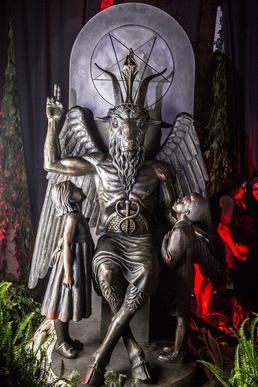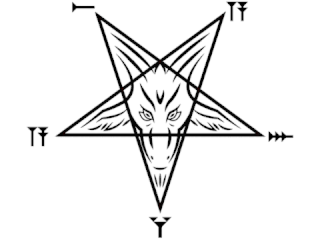Related Research Articles

Satanism is a group of ideological and philosophical beliefs based on Satan. Although several historical precedents exist, the contemporary religious practice of Satanism began with the founding of the atheistic Church of Satan by Anton LaVey in the United States in 1966. Prior to that time, Satanism existed primarily as the subject of accusations by various Christian groups toward perceived ideological opponents rather than a self-identity or expressed religious belief. Satanism, and the concept of Satan, has also been used by artists and entertainers for symbolic expression.

The Temple of Set is an occult initiatory order founded in 1975. A new religious movement and form of Western esotericism, the Temple espouses a religion known as Setianism, whose practitioners are called Setians. This is sometimes identified as a form of Satanism, although this term is not often embraced by Setians and is contested by some academics.

The Church of Satan is a religious organization dedicated to the religion of LaVeyan Satanism as codified in The Satanic Bible. The Church of Satan was established at the Black House in San Francisco, California, on Walpurgisnacht, April 30, 1966, by Anton Szandor LaVey, who was the church's High Priest until his death in 1997. In 2001, Peter H. Gilmore was appointed to the position of high priest, and the church's headquarters were moved to Hell's Kitchen, Manhattan, New York City.

Anton Szandor LaVey was an American author, musician, and Satanist. He was the founder of the Church of Satan and the religion of Satanism. He authored several books, including The Satanic Bible, The Satanic Rituals, The Satanic Witch, The Devil's Notebook, and Satan Speaks! In addition, he released three albums, including The Satanic Mass, Satan Takes a Holiday, and Strange Music. He played a minor on-screen role and served as technical advisor for the 1975 film The Devil's Rain and served as host and narrator for Nick Bougas' 1989 mondo film Death Scenes.

A Black Mass is a ceremony typically said to be celebrated by various Satanic groups. It has allegedly existed for centuries in different forms and is directly based on, and is intentionally a sacrilegious and blasphemous mockery of, a Catholic Mass.

The Satanic Bible is a collection of essays, observations, and rituals published by Anton LaVey in 1969. It is the central religious text of LaVeyan Satanism, and is considered the foundation of its philosophy and dogma. It has been described as the most important document to influence contemporary Satanism. Though The Satanic Bible is not considered to be sacred scripture in the way that the Christian Bible is to Christianity, LaVeyan Satanists regard it as an authoritative text as it is a contemporary text that has attained for them scriptural status. It extols the virtues of exploring one's own nature and instincts. Believers have been described as "atheistic Satanists" because they believe that God and Satan are not external entities, but rather projections of an individual's own personality—benevolent and stabilizing forces in their life. There have been thirty printings of The Satanic Bible, selling over a million copies.
LaVeyan Satanism is an atheist religion founded in 1966 by American occultist and author Anton LaVey. Scholars of religion have classified LaVeyan Satanism as a new religious movement and a form of Western esotericism.

Anime Boston is an annual three-day anime fan convention held in the spring in Boston, Massachusetts, United States. Anime Boston was created and is run by the New England Anime Society, Inc., a Massachusetts-based non-profit organization.

Theistic Satanism, otherwise referred to as religious Satanism, spiritual Satanism, or traditional Satanism, is an umbrella term for religious groups that consider Satan, the Devil, to objectively exist as a deity, supernatural entity, or spiritual being worthy of worship or reverence, whom individuals may contact and convene with, in contrast to the atheistic archetype, metaphor, or symbol found in LaVeyan Satanism. Organizations who uphold theistic Satanist beliefs most often have few adherents, are loosely affiliated or constitute themselves as independent groups and cabals, which have largely self-marginalized. Another prominent characteristic of theistic Satanism is the use of various types of magic. Most theistic Satanist groups exist in relatively new models and ideologies, many of which are independent of the Abrahamic religions.
Satanism is a belief or social phenomenon that features the veneration or admiration of Satan or a similar figure.
Greater and lesser magic, within LaVeyan Satanism, designate types of beliefs with the term greater magic applying to ritual practice meant as psychodramatic catharsis to focus one's emotions for a specific purpose and lesser magic applied to the practice of manipulation by means of applied psychology and glamour to bend an individual or situation to one's will.
Hail Satan, sometimes Latinized as Ave Satanas or Ave Satana, is an exclamation used by some Satanists to invoke the name of Satan in contexts ranging from sincere expression to comedy or satire. The Satanic Temple uses the phrase as a sincere expression of rational inquiry removed from supernaturalism and archaic tradition-based superstitions.
Within the Church of Satan, a Grotto is a clandestine association or gathering of Satanists within geographical proximity for means of social, ritual, and special interest activities. The Black House, the founding place and headquarters of the Church of Satan from 1966 to 1997, was effectively the first grotto, and was for a time referred to as the "Central Grotto". Grottos existed for a time in various parts of the United States; these included the Babylon Grotto in Detroit, the Stygian Grotto in Dayton, and the Lilith Grotto in New York. In 1975, LaVey disbanded all grottos, then reinstated them in the 1980s. The Church of Satan no longer formally recognizes or charters grottos.

The Satanic Temple (TST) is a non-theistic religious organization and new religious movement that is primarily based in the United States, with additional congregations in Australia, Canada, Finland, Germany, and the United Kingdom. Co-founded by Lucien Greaves, the organization's spokesperson, and Malcolm Jarry, the organization uses Satanic imagery to promote civil rights, egalitarianism, religious skepticism, social justice, secularism, and the separation of church and state, supporting their mission "to encourage benevolence and empathy [among all people]." The Satanic Temple has utilized religious satire, theatrical ploys, humor, and legal action in their public campaigns to "generate attention and prompt people to reevaluate fears and perceptions", and to "highlight religious hypocrisy and encroachment on religious freedom."

Douglas Mesner, better known as Lucien Greaves, is a social activist and the spokesman and co-founder of The Satanic Temple.

After School Satan is an after school program project of The Satanic Temple, a non-theistic American religious organization based in Salem, Massachusetts, and is sponsored by Reason Alliance LTD, a 501(c)(3) non-profit organization. It was created as an alternative to Christian-based after-school groups, specifically at schools that host the Evangelical Good News Club. The program neither teaches about Satanism nor attempts to convert club-goers; they instead teach about rationalism and understanding the world around us. It is against the beliefs of the Satanic Temple to teach religious practice in schools, which is opposite to how the Good News Club functions. The Satanic Temple rejects supernatural beliefs and views Satan as a literary symbol of rebellion against authority, not as a supernatural entity.

The statue of Baphomet is a bronze sculpture commissioned by The Satanic Temple depicting Baphomet, a winged, goat-headed, humanoid symbol of the occult. First unveiled in Detroit in 2015, the statue stands 8.5 feet (2.6 m) tall, weighing over 3,000 lbs., and features a prominent pentagram as well as two smiling youths gazing up at the seated central figure. Petitions to display the piece on public grounds have resulted in arguments concerning the separation of church and state. Production of the statue, and its initial notoriety, is featured in the documentary Hail Satan? (2019).

Hail Satan? is a 2019 American documentary film about the origins of The Satanic Temple, including the group's grassroots political activism. Directed by Penny Lane, the film premiered at the 2019 Sundance Film Festival, and was released in the United States on April 19, distributed by Magnolia Pictures. The film follows Satanists working to preserve the separation of church and state against the privileges of the Christian right.

Joy of Satan Ministries, also referred to as Joy of Satan (JoS), is a website and western esoteric occult organization founded in 2002 by Andrea M. Dietrich (a.k.a. Maxine Dietrich). Joy of Satan Ministries advocates "Spiritual Satanism", an ideology that presents a synthesis of Theistic Satanism, Nazism, Gnostic Paganism, Western esotericism, UFO conspiracy theories and extraterrestrial beliefs similar to those popularized by Zecharia Sitchin and David Icke.
A Bible desecration is the treatment of the Bible in a way that is intended to be disrespectful or insulting. Bible desecration is considered to be blasphemous and sacrilegious in Christianity.
References
- 1 2 3 "SatanCon: World's 'largest gathering of Satanists' hails diversity, fellowship". USA Today . Retrieved 2023-06-08.
- 1 2 3 Swezey, Victor (2023-04-29). "Masked Neo-Nazis Crash World's Largest Satanic Event". The Daily Beast . Retrieved 2023-06-08.
- ↑ "SatanCon, poking at religion and government, opens this weekend in Boston". NBC News . 2023-04-25. Retrieved 2023-06-08.
- 1 2 Pitts, William (2022-02-12). "Satanic Temple holds inaugural convention in Scottsdale". KPNX . Retrieved 2022-02-16.
- 1 2 "The Satanic Temple to hold 1st conference, SatanCon 2022, in Scottsdale". The Arizona Republic. Retrieved 2023-06-08.
- ↑ Mutasa, Tammy (April 28, 2023). "SatanCon, the Satanic Temple convention, comes to Boston this weekend". CBS News Boston.
- 1 2 3 Shenoy, Rupa; Ruckstuhl, Laney (April 21, 2023). "Boston's SatanCon expected to be largest ever gathering of Satanists". WBUR . Retrieved 2023-06-08.
- 1 2 3 Soebroto, Ashley; Cutler, Sonel (January 10, 2023). "Get ready for SatanCon 2023: 'The largest satanic gathering in history' is coming to Boston – The Boston Globe". Boston Globe . Retrieved 2023-06-08.
- ↑ Matthew, Zoe (2023-04-26). "Satanic Temple co-founder on reclaiming Satan, and Boston's SatanCon this weekend". GBH News. Retrieved 2023-06-08.
- ↑ Rodriguez • •, Irvin (2023-04-29). "SatanCon 2023 Celebrates 10-Year Anniversary in Boston This Weekend". NBC Boston. Retrieved 2023-06-08.
- 1 2 "The Satanic Temple: Think you know about Satanists? Maybe you don't". BBC . 2023-05-19. Retrieved 2023-06-08.
- ↑ Lewis, Kaitlin (2023-04-28). "Christians plan "ambush" of Satanic Temple's convention". Newsweek . Retrieved 2023-06-08.
- ↑ CNA. "Call to 'intense' prayer: Boston Archdiocese responds to Satanic Temple's convention". Catholic News Agency . Retrieved 2023-06-08.
- ↑ Ramirez, Leon (2023-05-08). "AI-generated images of satanic kids' event misrepresented as real". Associated Press . Retrieved 2023-06-08.